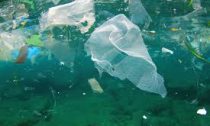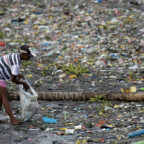
Greetings and welcome to Plastic Free July! This month, millions of people across 177 countries have pledged to cut down on the amount of plastic they use. The movement started small almost a decade ago in Australia, but last year more than 250 million people pledged to participate. This year, the annual challenge arrives as plastic is making something of a comeback amid the coronavirus pandemic.
Efforts to ban plastic bags in cities across the United States have stalled and some grocery stores won’t allow customers to bring their own reusable bags. Many restaurants are open for takeout service only, and that means disposable containers and flatware. A lot of the masks people wear are laced with microplastics.
While health should be the primary concern during a pandemic, “Caring for the planet doesn’t mean we can’t care for ourselves,” said Rebecca Prince-Ruiz, who founded Plastic Free July in 2011 as a challenge for herself, her family and a few others. “We can do both at the same time.”
Even if this year is complicated, breaking free from our normal routines — whether by skipping the bottled water, cooking at home more or shopping at a farmers’ market — can present an opportunity, said Susan Clayton, chair of the psychology department at The College of Wooster in Ohio. “When you’re forced to think about your behaviors instead of behaving automatically on the basis of habit, that provides you an opportunity to think about how you behave.”
Group actions like Plastic Free July can also foster a sense of connectedness. “It makes you feel like you’re doing something good, in line with your values, and that’s good for self esteem,” Dr. Clayton said. “And it can make you feel more powerful. When it comes to global climate change, a lot of people feel so helpless.”
That was echoed by John P. Holdren, a professor at Harvard’s Kennedy School of Government: Even if climate change feels overwhelming, small actions can make a difference.
“It matters a great deal what people do as individuals to reduce their impact on the environment,” said Dr. Holdren, who also served as a science adviser to President Barack Obama, in an email.
The government plays an important role in regulation and clean energy research, Dr. Holdren said, yet personal decisions, from the appliances we purchase to the way we commute, can “add up to significant shares of pollution and impacts on global climate.”
If you want tips to help cut down, check out this plastic-focused issue of Climate Fwd: and the additional reader suggestions that followed. The Plastic Free July website has plenty of resources, too. You might even want to take the plastic-free challenge.
The coronavirus has made face masks a fact of life, at least for now. So how do you choose one that will keep you safe without being too hard on the environment?
There are basically four choices: N-95 respirators, surgical masks, reusable cloth face coverings and disposable paper masks.
N-95 respirators, which create a facial seal, and surgical masks offer the best protection. Experts say that for general use, though, the difference in safety is small while the contrast in sustainability is vast. The best bet for a reasonable balance of protection and sustainability, some say, is a reusable cloth mask.
Mark Nicas, an adjunct professor at the University of California Berkeley’s School of Environmental Health Sciences, estimated that, when worn properly, surgical masks and cloth masks are about equal (75 percent effective) when it comes to reducing the spread of viral droplets to people around you.
Cloth masks are less efficient at protecting you against droplets from others (about 50 percent effective for cloth, compared with 75 percent for surgical masks).
In terms of sustainability, however, “there is no question” that cloth masks are better for day-to-day use, said Gang Sun, a researcher in fiber and textile chemistry at the University of California, Davis.
That’s because medical grade N-95 masks and surgical masks are generally not reusable and usually made from synthetic materials that, like plastic, derive from petroleum and similarly do not break down quickly in landfills.
The same is true of disposable paper masks, which usually contain a lot of microplastics. A study by the University of College London’s Plastic Waste Innovation Hub found that if all 68 million residents of Britain were to wear one disposable mask everyday day for a year, it would amount to roughly 73,000 tons of plastic waste.
One other consideration: It’s important to reserve N95 respirators for health workers, who are more often exposed to both airborne droplets and fluid hazards like splashes and sprays.
The discussion doesn’t end there, though, because some cloth face coverings are greener than others.
Dr. Megan R. Schwarzman, a physician and environmental health researcher at University of California, Berkeley, suggested using masks made from remnant fabric or making your own face covering from household textiles like old T-shirts.
“Virgin fiber of any kind is going to require more energy, more resources and more toxic chemicals than something that has already been made,” Dr. Schwarzman said.
She says her choice for everyday protection is an item most people already have in their homes: a cotton bandanna.















Social Profiles